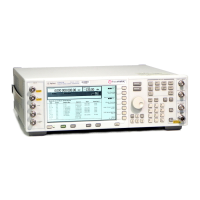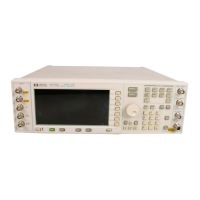510 Chapter 16
W-CDMA Uplink Digital Modulation for Receiver Test
DPCH
9. Press Return.
A third transport channel has been turned on and configured to use 1/3 convolutional encoding with a rate
match attribute of 256. Changing channel parameters can affect your puncture rate, and they may also affect
the parameters for other active channels. Whenever parameters are changed in one channel, check the other
channels to ensure their parameters are still within acceptable limits. Notice that decreasing the block size
for transport channel two lowered the data rate which in turn decreased the amount of data that would be
punctured. Puncturing can also be reduced by increasing the DPDCH symbol rate.
Configuring the E4440A PSA for Viewing Additive Noise
1. Select the spectrum analysis mode.
Press
Mode > Spectrum Analysis.
2. Set the center frequency to 1.95 GHz.
Press
Frequency > 1.95 > GHz.
3. Set the span to 10 MHz.
Press
Span > 10 > MHz.
4. Average the signal for better viewing.
Press
BW/Avg > Average On Off to On.
5. Remove text showing average value from the display.
Press
ESC.
Adding Noise
The tasks in this procedure build upon the procedure “Viewing and Adjusting the Compressed Mode Signal”
on page 525. There are two ways that you can set your carrier to noise ratio (C/N). One is by directly
entering your C/N value and the other is by setting the energy per bit to noise ratio (E
b
/N
o
) value. Setting
your E
b
/N
o
will change your C/N and the opposite is also true.
The following ESG tasks teach you how to set the overall C/N ratio for the uplink W-CDMA signal and the
E
b
/N
o
value referenced to individual physical or transport channels.
Setting the Carrier to Noise Ratio
1. Press
Mode Setup to return to the top-level real-time W-CDMA menu.
2. Press
Link Control > PhyCH Setup > DPCH AWGN Setup > Channel State Off On to On.

